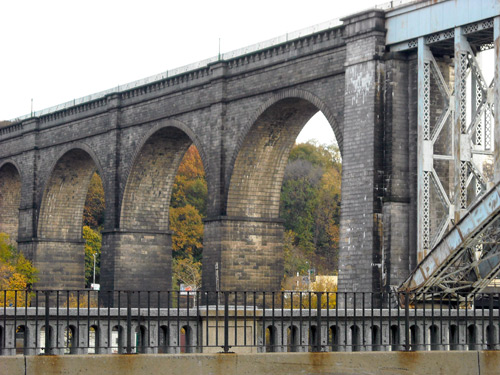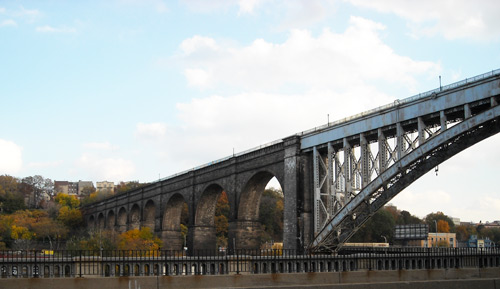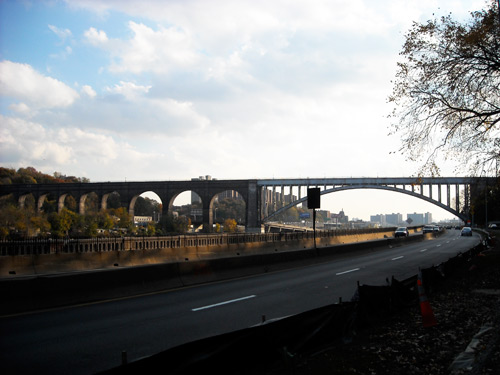High Bridge

High Bridge (Harlem River Bridge; Aqueduct Bridge)
Harlem River at West 170th Street, Bronx to High Bridge Park, Manhattan
John B. Jervis, Chief Engineer
1839-1848
Highbridge, opened in 1848, is New York City’s oldest surviving bridge. As the first stone structure to connect Manhattan and the mainland, it had been an engineering challenge. Nothing as long—1, 450 feet—or as high—126 feet—had yet been attempted in the United States. Spanning the Harlem River valley on sixteen piers, five of them raised on pilings driven with great difficulty into the river bed, Highbridge took a full nine years to finish. Its mass of granite ashlar supported neither a roadway nor railway, but only two forty-eight inch iron pipes—the final links in the Croton Aqueduct, which brought to New York pure and abundant Westchester water, absolutely essential for its survival.
An elevated aqueduct making a triumphal entrance into a city is an architectural tradition that goes back to Imperial Rome. Gravity-driven water passed from the mountains in precisely-engineered canals and tunnels buried in embankments, rarely emerging on bridges. In effect, the aqueduct was invisible until it neared the capital, where the characteristic tall stone arcades with repeating semicircular arches made their appearance. The forty-mile approach of the Croton Aqueduct to Manhattan was similarly concealed. Highbridge offered John B. Jervis, master engineer of the Croton, the opportunity to monumentalize his great public works achievement.
Inevitably, he imitated the Roman design, and even outdid its austerity, substituting simple spans for the tiers of superimposed arches with which the ancient architects usually attained height. Jervis seems nevertheless to have aimed at two specific visual effects. One is thinness in his tall piers, achieved through inventive construction that lightened the load of upper masonry. The impression is most spine tingling on the Bronx shore of the river, where verticals narrowing to only seven feet support six fifty-foot spans over Sedgwick Avenue and the Major Deegan Expressway. Also singular at Highbridge is the organization of changes in the arcade’s rhythm. Because of current and shipping, the river arches had to be wider, and the piers thicker, than those over land. Jervis (following the Romans), called attention to the alteration in the width of the arches by running a molding around each pier at the height of the springing where the vault separates itself. (When the semicircles expand to eighty-foot diameters, the springing perceptibly lowers.) To unify the run of nine wide piers, the middle and two end ones were made exceptionally broad. Finally, at the Manhattan shore, the bridge returned to its initial tempo, shortening stride for one final fifty-foot arch climbing the very steep hillside above today’s Harlem River Drive. Asymmetrical Highbridge was an intriguing set of variations:
[Bronx] a | a | a | a ||| A || A || A || A ||| A || A || A || A ||| a | [Manhattan].

Despite the care that he took in its composition, Jervis never wanted to build Highbridge. Even as he considered the project in 1838, he had determined that a U of pipes run into the Harlem valley and across the river on an embankment—with a single arch added to allow for tidal flow and boat traffic—could be built quickly and at half the expense. With an engineer’s logic, he opted for the low bridge; politicians, while regretting the loss “as far as architectural display is involved,” found his arguments irresistible. But Jervis’ hand was forced by irate Westchester landowners who wanted the Harlem kept open to shipping, which, they improbably imagined, would eventually turn their rural suburb into a part of New York City. Lobbying in Albany produced a statute demanding a river crossing at least 100 feet above water level, with spans at least eighty feet wide. Iron and suspension technology not yet having replaced the ancient craft of stone bridgework, it took an exasperated Jervis six years longer to finish the daunting bridge than to build the rest of his 51-mile aqueduct. For these final years of bridge construction, the desperately-needed water supply was already functioning, with the Harlem temporarily crossed by pipes— the “inverted siphon” Jervis had wanted to build in the first place. One of his assistants voiced a practical man’s disgust: “This will be the greatest work in the country—in fact, it is too great and uncalled for,... [adding] half a million just for Architectural beauty in a place where there is little necessity for it.”
Three quarters of a century later, the bridge was again experiencing rejection. By now the Bronx had become part of New York City. But it still had the nagging sense that want of river traffic was limiting its commercial opportunities. Persuaded to dredge a channel deep enough for large ships, the Federal Department of War balked at the width of Highbridge’s eighty-foot spans, on which barges occasionally hung themselves up. The Board of Trade’s remedy, backed by Commissioner Grover Whelan, was removal of the bridge (now no longer needed for water supply). This time an early manifestation of preservationist sentiment came to the aid of the orphan structure. Architects and editorialists spoke up for a bridge that had been “at once a monument and a delight for more than seventy years.” Decrying “an act of vandalism without precedent in the history of our country,” Scientific American inadvertently recalled the fate of the Roman aqueducts, cut by barbarians. The real key to settlement was City Hall’s awakening to the fact that it would cost more to pull down the bridge than to keep it. A “triumphant compromise between art and utility” was reached, and in 1928, five of the finely articulated river piers were replaced with a single metal arch, producing an incongruous stone-and-steel structure one journalist quickly dubbed the Hybrid.
Has utility, Highbridge’s lifelong enemy, finally triumphed? Whelan had argued that there would be no point in saving an altered bridge, since it “will lose its chief value, its scenic beauty, when the middle columns are replaced, breaking the regularity of the structure.” This pessimistic view can be defeated by the visitor’s imagination. Assisted by current efforts to restore parkland at either end of the bridge and re-open its long-neglected pedestrian promenade, and with the further help of a nineteenth-century engraving or photograph, he or she should be able to summon up picturesque isolation between heavily wooded hillsides and a reflection of fifteen arches in the river.
David Bady
UPDATE:
After being closed for forty years, the High Bridge walkway once again opened to pedestrians and bicyclists on June 9, 2015. It is open daily from 7:00 a.m. to 8:00 p.m.
Directions:
From the Bronx side, enter the High Bridge walkway at University Avenue and 170th Street.
- From the Manhattan side, enter from Highbridge Park at 172nd Street and Amsterdam Avenue. At the High Bridge Water Tower Terrace take the staircase down to the bridge level.
For ADA access, there is a ramp located at 167th Street and Edgecombe Avenue on the Manhattan side and on the Bronx side, take the ramp north of 170th Street and University Avenue.
- Lehman College Art Gallery



